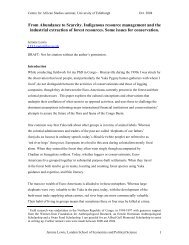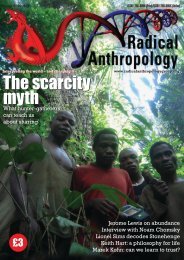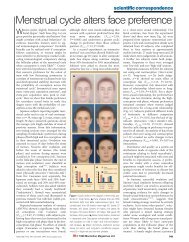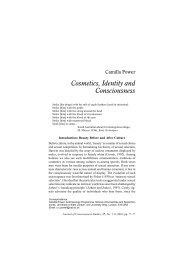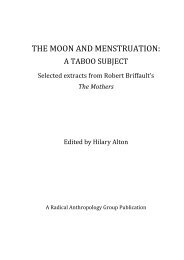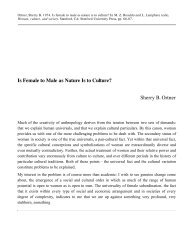Language and life history: A new perspective on the development ...
Language and life history: A new perspective on the development ...
Language and life history: A new perspective on the development ...
- No tags were found...
You also want an ePaper? Increase the reach of your titles
YUMPU automatically turns print PDFs into web optimized ePapers that Google loves.
Locke & Bogin: <str<strong>on</strong>g>Language</str<strong>on</strong>g> <str<strong>on</strong>g>and</str<strong>on</strong>g> <str<strong>on</strong>g>life</str<strong>on</strong>g> <str<strong>on</strong>g>history</str<strong>on</strong>g>males, since it is generally <strong>the</strong> case, across <strong>the</strong> animalkingdom, that females choose <strong>the</strong>ir mates <strong>on</strong> <strong>the</strong> basis ofperceptible traits (Anderss<strong>on</strong> 1994; Mealey 2000), presumablybecause <strong>the</strong>y have more to lose if <strong>the</strong>y make abad choice (Trivers 1972). Accordingly, several scholarshave sought support for a sexual selecti<strong>on</strong> hypo<strong>the</strong>sis,but not without disappointment (e.g., Fitch 2004; Miller2000), since <strong>the</strong> literature, read uncritically, has suggestedthat males perform worse than females <strong>on</strong> a variety ofverbal tests, doing so across <strong>the</strong> <str<strong>on</strong>g>life</str<strong>on</strong>g>span, beginning in<strong>the</strong> early stages of language <strong>development</strong> (Fens<strong>on</strong> et al.1994; Huttenlocher et al. 1991; Lutchmaya et al. 2002;Morisset et al. 1995). A more comprehensive review of<strong>development</strong>al studies, however, indicates that boys so<strong>on</strong>catch up with girls (Bar<strong>on</strong>-Cohen et al. 2004); <str<strong>on</strong>g>and</str<strong>on</strong>g> acloser inspecti<strong>on</strong> of <strong>the</strong> tests that are administered toolder children <str<strong>on</strong>g>and</str<strong>on</strong>g> adults reveals carefully timed, verballyinstructed measures of anagram ability, vocabulary, verbalmemory, word associati<strong>on</strong>, <str<strong>on</strong>g>and</str<strong>on</strong>g> reading comprehensi<strong>on</strong>(Hines 1990; Kimura 2002; Maccoby & Jacklin 1974).The requisite skills are not displayed sp<strong>on</strong>taneously <str<strong>on</strong>g>and</str<strong>on</strong>g>vibrantly in public before an audience of resp<strong>on</strong>sivepeers, but quietly <str<strong>on</strong>g>and</str<strong>on</strong>g> obediently in <strong>the</strong> seclusi<strong>on</strong> of testrooms, typically with a paper <str<strong>on</strong>g>and</str<strong>on</strong>g> pencil.Even <strong>on</strong> <strong>the</strong>se tests, <strong>the</strong> female advantage has beennegligible; in <strong>the</strong>ir meta-analysis of 165 studies, Hyde<str<strong>on</strong>g>and</str<strong>on</strong>g> Linn (1988) call <strong>the</strong> gender difference “so small thatit can effectively be c<strong>on</strong>sidered to be zero” (p. 64). Butwhere, <strong>on</strong>e might ask, is <strong>the</strong> male advantage that biologistshave come to expect? If it exists, male superiority would befound in vocal or verbal skills that are indicative of fitness.One would expect <strong>the</strong>se to be observable in <strong>the</strong> public useof language by adolescents <str<strong>on</strong>g>and</str<strong>on</strong>g> young adults, <str<strong>on</strong>g>and</str<strong>on</strong>g> this iswhere <strong>the</strong>y are witnessed. C<strong>on</strong>sistent with a sexual selecti<strong>on</strong>hypo<strong>the</strong>sis, anthropological research, as we haveseen, reveals that performative applicati<strong>on</strong>s of languagein <strong>the</strong> form of speech <str<strong>on</strong>g>and</str<strong>on</strong>g> voice c<strong>on</strong>sistently favor males.Did performative ability increase fitness? Miller (2000)has argued that sexual selecti<strong>on</strong> shaped human languagedirectly (epigamically), through mate choice, <str<strong>on</strong>g>and</str<strong>on</strong>g>indirectly, through its effects <strong>on</strong> social status.Verbal courtship can be viewed narrowly as face-to-face flirtati<strong>on</strong>,or broadly as anything we say in public that mightincrease our social status or pers<strong>on</strong>al attractiveness in <strong>the</strong>eyes of potential mates. Sexual flirtati<strong>on</strong> during early courtshipaccounts for <strong>on</strong>ly a small percentage of language use, but it is<strong>the</strong> percentage with <strong>the</strong> most important evoluti<strong>on</strong>ary effects.This is <strong>the</strong> time when <strong>the</strong> most important reproductivedecisi<strong>on</strong>s are made, when individuals are accepted or rejectedas sexual partners <strong>on</strong> <strong>the</strong> basis of what <strong>the</strong>y say. (Miller 2000,pp. 356–57)Spoken language may also have played a role in sexualselecti<strong>on</strong> outside of courtship (intrasexually) by publicizingvarious male qualities. It was through public speaking <str<strong>on</strong>g>and</str<strong>on</strong>g>debate, according to Miller, that individuals were able toadvertise <strong>the</strong>ir knowledge, clear thinking, social tact, goodjudgment, wit, experience, morality, imaginati<strong>on</strong>, <str<strong>on</strong>g>and</str<strong>on</strong>g> selfc<strong>on</strong>fidence.Under Pleistocene c<strong>on</strong>diti<strong>on</strong>s, <strong>the</strong> sexual incentivesfor advertising such qualities would have persisted throughoutadult <str<strong>on</strong>g>life</str<strong>on</strong>g>, in almost every social situati<strong>on</strong>. <str<strong>on</strong>g>Language</str<strong>on</strong>g> put minds<strong>on</strong> public display, where sexual choice could see <strong>the</strong>m clearlyfor <strong>the</strong> first time in evoluti<strong>on</strong>ary <str<strong>on</strong>g>history</str<strong>on</strong>g>. (Miller 2000, p. 357)We agree that “language” helped to exhibit <strong>the</strong>sequalities, but it could not have d<strong>on</strong>e so without <strong>the</strong>assistance of a powerful accomplice, <strong>on</strong>e whose acti<strong>on</strong>has escaped <strong>the</strong> notice of most <strong>the</strong>oreticians. It wasspeech. Although speech is often thought of as little morethan a system for transmitting linguistically encoded informati<strong>on</strong>,it has qualities of its own, qualities that attractattenti<strong>on</strong>. Without attenti<strong>on</strong> <strong>the</strong>re will be few listeners,<str<strong>on</strong>g>and</str<strong>on</strong>g> little exposure to <strong>the</strong> individual’s language <str<strong>on</strong>g>and</str<strong>on</strong>g> mind.In <strong>the</strong> case of speech, unlike language, <strong>the</strong>re are clear<str<strong>on</strong>g>and</str<strong>on</strong>g> c<strong>on</strong>sistent differences between males <str<strong>on</strong>g>and</str<strong>on</strong>g> females.6. Sex effects in speechWe have witnessed a str<strong>on</strong>g trend for verbal performancesto be carried out by adolescents <str<strong>on</strong>g>and</str<strong>on</strong>g> adults who are male.At <strong>the</strong>se same stages, however, females are more likely toengage in intimate talk, especially talk that includes selfdisclosure(Derlega et al. 1993; Mort<strong>on</strong> 1978), whe<strong>the</strong>rin traditi<strong>on</strong>al or modern societies.As we saw earlier, <strong>the</strong> dispositi<strong>on</strong> to gossip – that is, todisclose informati<strong>on</strong> about o<strong>the</strong>rs – also increases duringadolescence, especially in females. Studies of womenacross two educati<strong>on</strong>al levels, several different cultures,<str<strong>on</strong>g>and</str<strong>on</strong>g> eight decades in <strong>the</strong> twentieth century agree thatadult women are also more likely to gossip than men(Bischoping 1993; also see Locke 2005). The reas<strong>on</strong> mayhave to do with <strong>the</strong> fact that gossip serves an affiliativefuncti<strong>on</strong> (Emler 2001), <str<strong>on</strong>g>and</str<strong>on</strong>g> that females tend to cometoge<strong>the</strong>r in times of stress (Taylor et al. 2000). InEngl<str<strong>on</strong>g>and</str<strong>on</strong>g>, gossip networks have existed for at least fivehundred years (Capp 2003). Membership in such networksis required for mutual aid, <str<strong>on</strong>g>and</str<strong>on</strong>g> <strong>the</strong> cost of membershipis willingness to gossip. The rules are simple,according to a report <strong>on</strong> modern English networks: “nogossip, no compani<strong>on</strong>ship” (Bott 1971). 10Although sex differences in speaking are frequentlyattributed to culture (Mey 1985), <strong>the</strong> patterns identifiedhere cut across cultures. The adolescent male attracti<strong>on</strong>to verbal dueling may also be supported by physiologicalfactors. C<strong>on</strong>sider <strong>the</strong> widely attested associati<strong>on</strong> betweentestoster<strong>on</strong>e <str<strong>on</strong>g>and</str<strong>on</strong>g> physical aggressi<strong>on</strong> (Dabbs 2000). Sinceadolescent males, who have relatively high levels of testoster<strong>on</strong>e,need ways to avoid hurting <strong>the</strong>mselves, it may beadaptive for <strong>the</strong>m to use verbal sport <str<strong>on</strong>g>and</str<strong>on</strong>g> humor in placeof combat (Marsh 1978). C<strong>on</strong>sistent with this possibilityis <strong>the</strong> fact that verbal duelists always “lose,” <str<strong>on</strong>g>and</str<strong>on</strong>g> <strong>the</strong>c<strong>on</strong>tests are always stopped, if <strong>the</strong> participants becomeangry (Kochman 1969; 1983). Therefore, we speculatethat testoster<strong>on</strong>e promotes verbal dueling (see <strong>the</strong>reference to trial lawyers in sect. 8). 11When adolescent females wish to aggress againstano<strong>the</strong>r member of <strong>the</strong>ir sex, <strong>the</strong>y frequently use gossipto enlist <strong>the</strong> support of peers, greatly surpassing males inthis practice. Like males’ involvement in public performances,this difference between <strong>the</strong> sexes surfaces inlate juvenility, spans a number of different cultures, <str<strong>on</strong>g>and</str<strong>on</strong>g>c<strong>on</strong>tinues through adolescence into adulthood (Björkqvistet al. 1992a; 1992b; 1994; Burbank 1994; also see Crick &Bigbee 1998; Galen & Underwood 1997).Private disclosures bear little resemblance to publictaunts, but <strong>the</strong>ir functi<strong>on</strong>s are similar. In gossip as wellas rap, verbal skill is used to raise <strong>on</strong>e’s own status, <str<strong>on</strong>g>and</str<strong>on</strong>g>to lower that of competitors, while also broadcasting <str<strong>on</strong>g>and</str<strong>on</strong>g>enforcing community st<str<strong>on</strong>g>and</str<strong>on</strong>g>ards (Abrahams 1973). These270 BEHAVIORAL AND BRAIN SCIENCES (2006) 29:3



